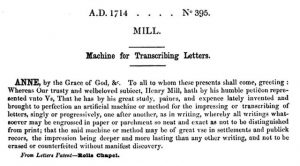A typed version of Henry Mill’s original patent on the concept of the typewriter
Henry Mill was born 1683 in England where he lived most of his life. He was the eldest son of Andrew and Dorothy Mill and was given a position at the New River Company in 1720 as an engineer.[2] However, it was in 1714 that he finalized they patent for the first concept of the typewriter. While there was no physical description of the machine nor a physical invention, Mill is credited with the first idea for the typewriter. The patent described the machine as, “…for impressing or transcribing of letters singly or progressively one after another, so neat and exact as not to be distinguished from print…very useful in settlements and public records.”[3] While conventional typewriters did not come along until much later, a few notable ancestors helped pave the way for this invention. Early models like the Hansen writing ball are the beginning of the development of the modern typewriter design. The Writing ball was developed by Reverend Rasmus Malling-Hansen and one of the first commercially sold typewriters, one of the largest uses of the device was in the offices of businesses all across Europe. However, its design was off putting and was not as efficient as it could be compared to the typewriters that we know today. While the first commercially successful typewriter, the Sholes and Glidden Typewriter, didn’t come out until 1868 and was a massive success. [4] While there have been many other typewriter prototypes to have come before this, there was only one patent, that of Henry Mill. As time went on and typewriters became more advanced, the main use of typewriters was essentially the same. They were a much faster way to record information as opposed to writing and though we may not the typewrite as much as we used to, they principles of the device have been implemented in today’s modern technology. As time went on and more advancements were added to the design such as smoother keystrokes, ink ribbons, backspace keys, even electric typewriters that could create different fonts with just the switch of a cartridge, Mill’s idea remained the same. Much like Mill intended, the typewriters main commercial use was to organize information in order to properly file it for later use. With this idea, more and more innovations to the typewriter were developed that further allowed the user to create a message or record some data or even create a literary work faster and even more efficient that before. While there have been many advancements since then and a multitude of uses for the machine, the typewriter has not actually strayed that far from the original intention set forth by Mill himself. The proposed purpose was to help with record keeping and to help organize a settlements various businesses and local law. When most people think of the typewriter, they think of an office setting with secretaries and salary men typing up quarterly reports. The fact that the intended use of the typewriter is still used today is nothing short of impressive and it is all thanks to Henry Mill.
[1] Woodcroft, B. 1855. Reference index of patents of invention, from 1617 to 1852, by B. Woodcroft. [With] Appendix. Oxfod: Patent Office.
[2] Messenger, Robert. 2013. “Propagating Typewriter Myths: Grist for the Mill.” Oz Typewriter: The Wonderful World of Typewriters. November 27. Accessed March 27, 2017. http://oztypewriter.blogspot.com/2013/11/propagating-typewriter-myths-grist-for.html.
[3] Polt, Ricahrd. 2010. “A Brief History of Typewriters.” The Classic Typewriter page. April 30. Accessed March 27, 2017. http://site.xavier.edu/polt/typewriters/tw-history.html.
[4] Polt 10
